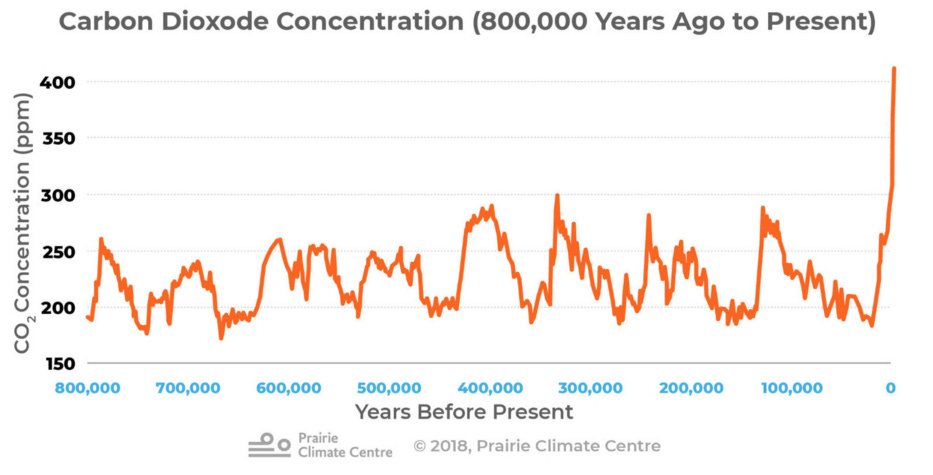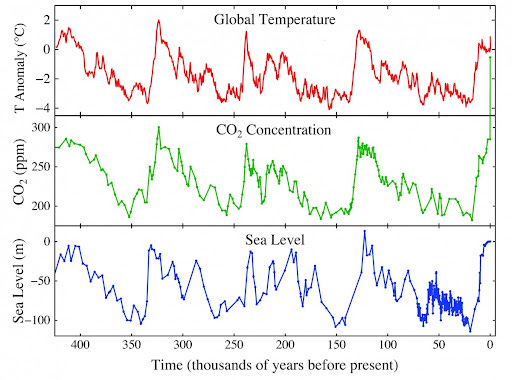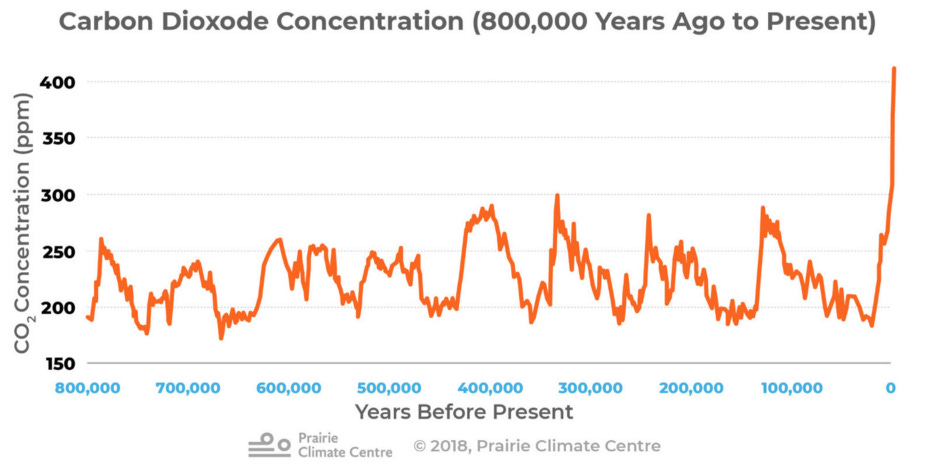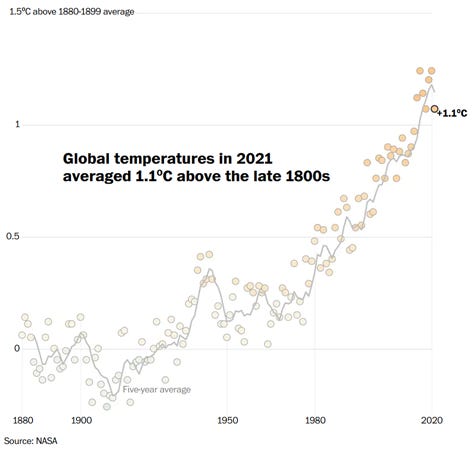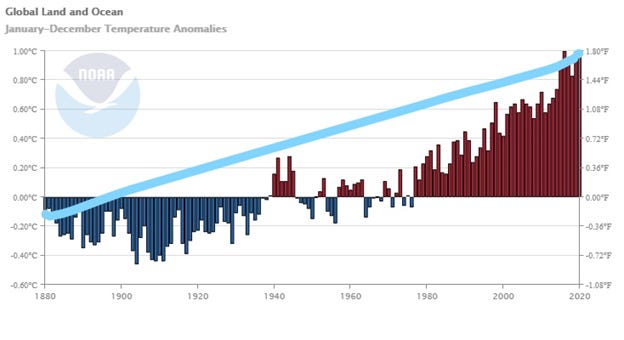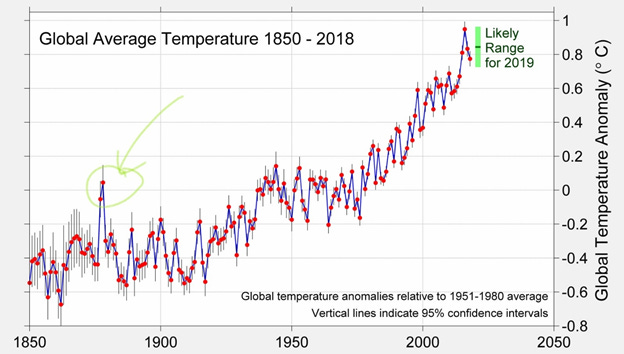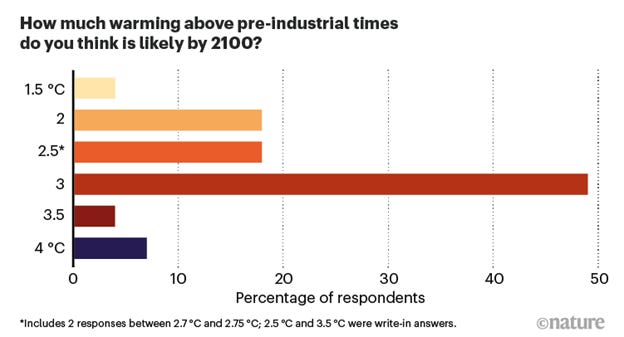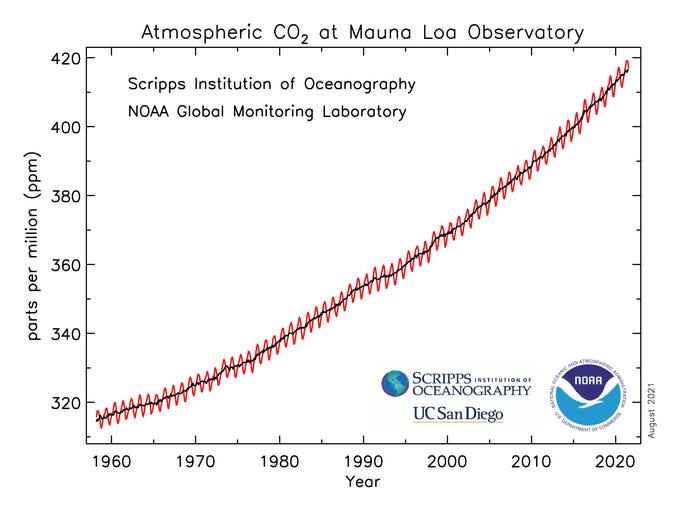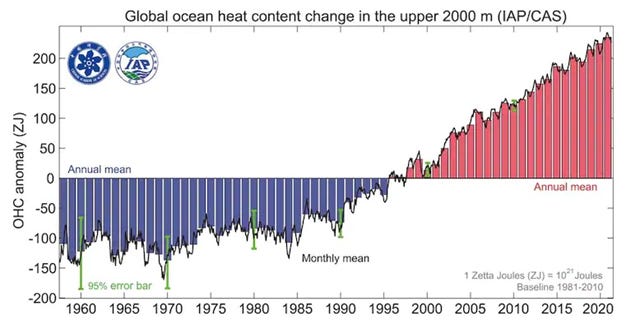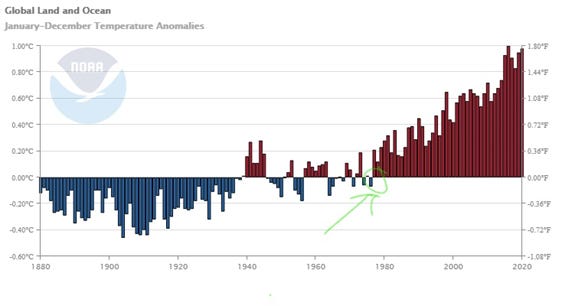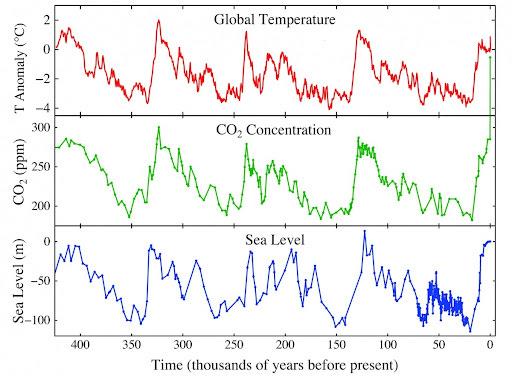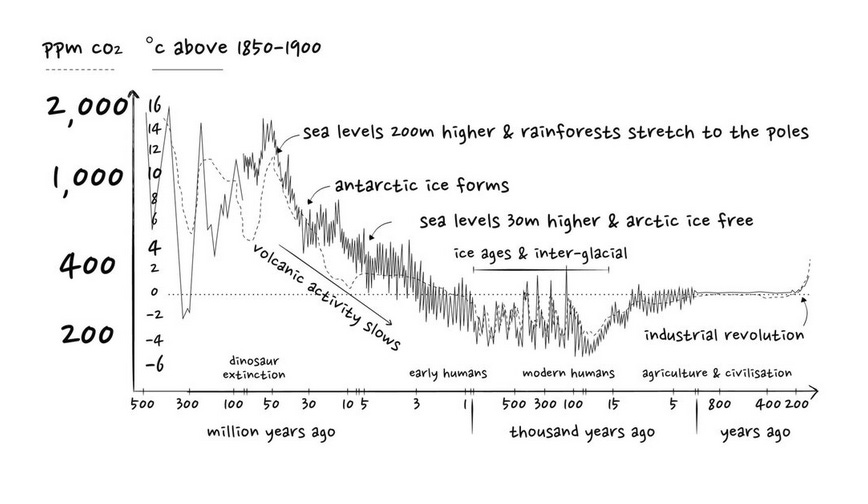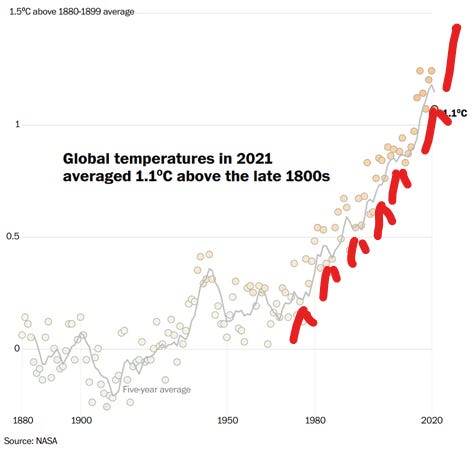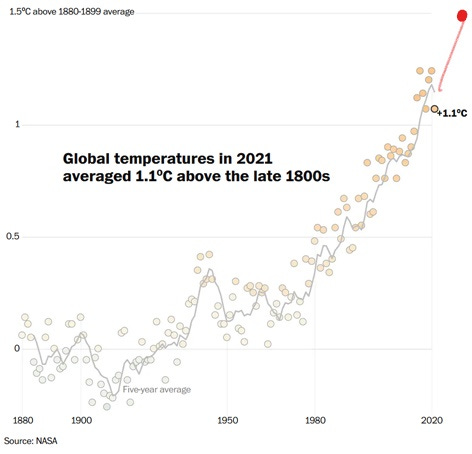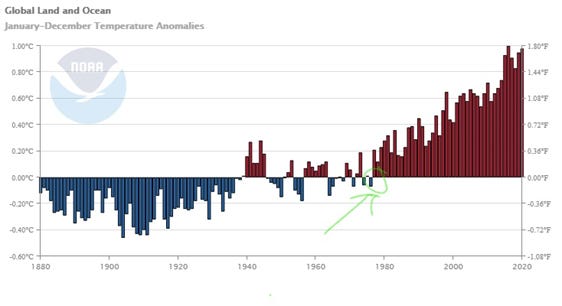
Specifically, let’s talk about why “Climate Science” was 30–40 years off on how fast the planet would warm up.
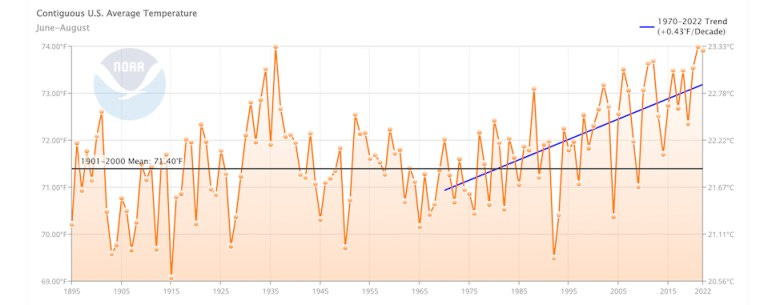
Because the ONLY way that can happen, is if we seriously underestimated the effect of CO2 on the Global Mean Temperature.
That’s what this means. It’s a “reality check” on our Climate Models and it’s obvious they are flawed. They understate the warming effect of CO2, probably by about 40%.
How can I be so confident about that estimate?
Because that’s how much “extra heat” we found in the oceans when we systematically started measuring them down to 2000m using the ARGO float system. We underestimated the amount of heat in the oceans by 40%, which implicitly means that we underestimated the effects of CO2 by 40%.
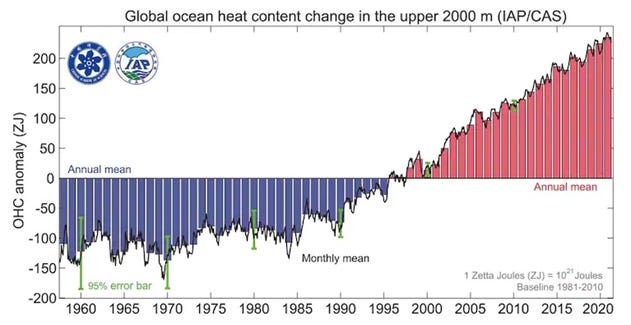
Here’s the takeaway I want you to remember. I’m going to yell because so few people seem to be grasping this.
OUR FUCKING CLIMATE MODELS ARE FLAWED, WE ARE WARMING MUCH FASTER THAN PROJECTED. THIS IS THE “NOW OR NEVER” MOMENT.
If you were in doubt about what’s happening with the Climate here’s another reality check on the models. The paleoclimate record that has been painstakingly constructed over the last sixty years.
We know exactly what the climate was like for the last 800,000 years because we have a high resolution climate record in the Greenland ice sheet. So we know with 100% certainty that CO2 levels for the last 800 thousand years have fluctuated between 180ppm and 280ppm. A range of about 100ppm.
The normal 100ppm range in CO2 levels, changes the Earth’s Global Temperature by about +-6℃.
The Greenland Ice Cores are invaluable because they provide context for what we have done.
The analysis of the Greenland Ice Cores is one of the truly monumental accomplishments of the 20th century. It’s on par with the sequencing of the Human Genome.
I remember watching films in grade school of this project starting. It was part of the interest in our growing understanding of how the Earth worked. Which got kicked off by The International Geophysical Year in 1957–1958.
They have been analyzing the Greenland ice cores my entire life. Every 4 or 5 years there has been a new paper or analysis of the data. As time passed they have been able to drill deeper and deeper back into time and the amount of information we have been able to extract from the cores has grown to levels undreamed of 60 years ago.
In 2021 researchers reached the bottom of the ice sheet and were shocked by what they found.
Scientists stunned to discover plants beneath mile-deep Greenland ice
Ancient Plants Buried a Mile Under Greenland’s Ice Are a Grim Warning From The Past
Fossil Plants at Bottom of the Greenland Ice Sheet Warn of Future Melting
At the bottom of a 1.4-kilometer (0.87-mile) ice core drilled from northwestern Greenland, scientists found remnants of ancient plant material.
This suggests that, at least once within the last million-year period, and multiple times in the few million years prior, Greenland’s ice sheet melted long enough during warm periods for significant vegetation — perhaps even a forest — to take root and thrive.
Which means that Greenland completely melted about 800,000 years ago. During a warm interglacial period when temperature levels and CO2 levels were lower than they are now.
It’s not a matter of “if” Greenland will melt, it’s become a question of “how fast”.
The Greenland Ice Cores are invaluable because they give us hard physical data about the relationship between increasing levels of CO2 in the atmosphere and increases in the planetary GMT.
Take a look again at the last 800K years of CO2 levels in the Earth’s atmosphere. What does it say to you?
What it says to me, is that we have been monumentally stupid.
Over the last 800,000 years a change of 100ppm in the level of CO2 in the atmosphere changed the global temperature by 6C. Does any rational person think the 140ppm of CO2 we have dumped into the Earth’s atmosphere since 1850 is “only” going to cause 1.5C of warming by 2100?
In light of the hard physical evidence it’s impossible to believe that much CO2 is only going to cause 1.5C of warming. So why are people still talking about 1.5C of warming like it means anything?
If the danger is this obvious, why aren’t we doing anything?
So, lets talk about what’s happening with “Climate Science” and why it’s obviously not in sync with the reality we are starting to experience. If the evidence is as clear as I say, why aren’t climate scientists speaking out?
To answer that question we have to talk about what “science” actually is and how it actually happens. It only loosely corresponds with the common perceptions of how science is done and how ideas become dominant during a period.
Here’s a term almost everyone is familiar with, “paradigm shift”.
Everyone sorta understands that it means an important change that happens when the usual way of thinking about or doing something is replaced by a new and different way. The old paradigm is replaced by a new paradigm, there’s a shift in the way everyone thinks about something.
A lot fewer people know that the term comes from the book The Structure of Scientific Revolutions by Thomas S. Kuhn. Fewer still, understand the implications of the book in terms of how we should think about “science”.
For me, one of the best things to emerge from the study of the history of science was the idea of the “paradigm shift”. Understanding how sets of cultural memes, ideas, practices, and attitudes change and morph over time is illuminating and useful when examining one’s culture.
One of the biggest takeaways for me regarding paradigm shifts is that they tend to be generational.
Even in scientific fields where you would expect that “the evidence should prevail”. Almost always, a previous generation has to literally “die off” before new paradigms can replace old ones.
Here’s something to consider. In most fields of study, the first generation of theories are often flawed and incomplete. How could they not be?
They are built on incomplete information.
New fields of study emerge, so that new things can be examined and explained. In the 1960’s we wanted to understand the Earth’s climate system in a “fact based” scientific way. So we started gathering data and creating explanations for what we found.
Climate Science is only about 60 years old.
What Kuhn found is that there is a very predictable pattern in scientific thought. At any given moment there is an existing paradigm that provides an explanation for the reality we observe around us and the majority accept and believe it.
A good paradigm that successfully explains the observable world can persist for a very long time. Paradigms get challenged when things that they cannot explain accumulate. This is often a slow generational process in scientific fields of study.
The guy who first proposed the theory of continental drift died before enough evidence accumulated that people realized he was right. The theory that an asteroid caused the extinction of the dinosaurs wasn’t proven until the 80’s. In the 19th century scientists spent decades searching for luminiferous aether (or ether).
Kuhn found, and numerous researchers have confirmed, that science is a social process.
How could it not be?
Science is done by people and is funded by even more people. People are social, political creatures. There is always a political component in science just like everything else in our social realities. To not understand and accept this, is to be naive.
How to you think 1.2℃ became accepted as the amount of warming that has been caused by CO2?
When you look at these two graphs.
It’s obvious that by using 1880 as your “late 19th century” baseline, you reduce the amount of global warming by roughly 0.6℃ or about 30%.
It goes from a “crisis level” of 1.8℃ that requires immediate large-scale reductions of fossil fuel use, to a “concerning level” of 1.2℃ that makes “the goal of 1.5℃” difficult, but not impossible, to achieve.
*To understand how this happened review “How much has the Earth warmed up since the “preindustrial” period? Surprisingly it’s hard to get a straightforward answer to that question.”
Setting the baseline for measuring Global Warming as 1880 was a political choice. It’s not reported that way. That’s a big part of why our models are so badly off.
When you look at this graph, what do you see?
Of the scientists who responded to this anonymous poll, 88% think global warming constitutes a crisis and nearly as many said they expect to see “catastrophic impacts of climate change in their lifetimes”.
Just under half said that global warming has caused them to reconsider major life decisions, such as where to live and “whether to have children”. More than 60% said that they experience anxiety, grief, or other distress because of concerns over climate change.
This information should concern and scare you. These are the most informed people on the planet on the topic of global warming. You should want to know why they think this is the most likely future. What do they know, what do they see, that the rest of us don’t?
Most importantly, why isn’t this what the IPCC reports are saying?
When I look at this graph I see Kuhn’s work manifested. I see the first generation of climate researchers, the ones who predicted that the climate system would be resistant to change, as the 20% who still think warming will be no worse than 2C by 2100.
Because the first generation of climate researchers laid the groundwork in Climate Science their opinions are very influential. Right now many of them control departments, institutions, and research budgets. They are the voices you are hearing when reporters tell you that “a prominent scientist says 1.5C is still possible if US cuts emissions by 75% in next five years”.
This is the medical equivalent of having 4 doctors tell you that you have cancer and need immediate surgery but choosing to listen to the 5th guy who tells you that if you lose weight, take vitamin supplements, and drink probiotic smoothies you’ll be fine. It could happen, but it seems unlikely.
Climate Science is in the process of a paradigm shift. It’s happening right now.
A massive amount of climate research is coming to fruition. The last five years has revolutionized our understanding of the Climate System. What we have learned is that we were monumentally stupid.
1976 was a Crucial Year for the Climate
We crossed a significant tipping point that year. Even though the oceans were still cooler than our baseline, temperatures have continuously risen since then.
After 1976, the warming effect of our accumulated CO2 emissions was great enough to override the cooling effect of the earth’s oceans. Since 1976 we have been pumping heat into the Climate System faster than the oceans can process it.
Temperatures are rising because the planet cannot get rid of this heat fast enough. This is the same thing that happens to your car’s radiator when you hold down the gas. Heat comes in faster than it can go out, and the radiator heats up.
1976 was the year we started overloading the planet’s Climate System.
We didn’t know that.
Sure, the Oil companies were doing some private Climate Model Studies that strongly indicated increasing levels of CO2 would warm the planet. Nobody knew about that.
People were obsessed with the idea that another Ice Age was about to start.
This isn’t as stupid as it sounds. Things had been much colder in the 19th century. There had been a major heatwave in the late 30’s and early 40’s. Followed by a plunge in global temperatures.
While things had been warming up, there was a lot of fear that they could turn cold again. This was amplified by some early findings in Climate Science research. Particularly, the discovery of a pattern in the periodicity of the Ice Ages.
It looks like Ice Ages happen roughly every 100,000 years.
This finding was seized on as proof of a theory put forth in the 1920’s by Serbian geophysicist and astronomer Milutin Milanković. In the 1920s, he hypothesized that variations in eccentricity, axial tilt, and precession combined to result in cyclical variations in the intra-annual and latitudinal distribution of solar radiation at the Earth’s surface, and that this orbital forcing strongly influenced the Earth’s climatic patterns.
The first analysis of the Greenland Ice Cores popularized the theory that the Climate System was driven by cycles in the Earth’s orbit, “Milankovitch Cycles”.
A lot of people believed that it meant another Ice Age was about to start. A lot of popular science fiction writers of the time, including Larry Niven and Jerry Pornelle, wrote science fiction novels about the coming Ice Age. This was very influential on how the next generation in the sciences perceived the climate.
If this seems like a stretch, have you heard of “The Ministry of the Future” by Kim Stanley Robinson? If you are the type of person who reads climate articles, I’ll bet you have.
Scientists are almost universally, science fiction fans. For a lot of them, it’s what steers them into the sciences. If you don’t understand how influential science fiction is on the sciences, you don’t understand the culture of science.
The first interpretation of the climate data being gathered, was that we were in a long term cooling cycle. Any warming being felt, was temporary. In the decades to come, it was going to get colder.
You still run into Climate Deniers making this argument. It influenced a whole generation.
It’s a perfect example of why first impressions can be misleading. Milankovitch Cycles are real. They clearly have a real effect on the Earth’s Climate. But, that effect is subtle and easily overridden by the effect of CO2 concentrations on the atmosphere.
We know this, because if you zoom out and look at the paleoclimate record on a longer timescale, the effect of the Milankovitch Cycles vanishes.
It’s really only noticeable for the last three million years. When CO2 levels have never gone much above 300ppm. In case you were not aware of it.
The last three million years we have been in the worst period of planetary glaciation in about 300 million years.
One of the important things this tells us, is that 180ppm seems to be the foundational level of atmospheric CO2 after geologic processes remove all excess from the system. The planetary level of CO2 never seems to fall below 180ppm.
None of this was known in 1976.
What we did know, was that we had to decide what we were going to do for energy in the decades to come.
We had just had a massive “oil shock” when OPEC flexed its growing power and showed us how dependent we had become on them. Punishing us for our support of Israel in the Arab-Israeli Wars, they had caused fuel prices to soar and Americans to have to stand in line for gas.
Carter needed to lay out an energy policy outline for the future. Here’s the information they had to work with at that time.
They could see that the level of atmospheric CO2 was rising rapidly. From 1958 to 1976 it went from 290ppm to 320ppm.
There was a theory that this rapid increase in the CO2 levels could affect the world climate and cause dangerous global warming.
How much warming? Unknown.
How rapid would any warming be? Unknown.
What effects would this warming cause? Uncertain, that was dependent on the degree and speed of any warming. Both of which were unknown.
Was it possible that the CO2 level was unimportant, that the planet was in a cooling phase that would override the effect of the increasing CO2 levels?
A lot of smart people were convinced this was the case.
What would you do?
Option One.
You shut down the usage of fossil fuels. The energy source for the whole economy. Forcing a crash transition to nuclear, wind, hydro, and solar power. Causing massive disruptions to every aspect of the economy and impacting the lives of everyone.
Option Two.
You take a more moderate approach. Funding further research and studies of the Earth’s Climate System. Continuing to use fossil fuels while encouraging the development of renewable energy sources. Starting a gradual reduction in fossil fuel usage that could be accelerated if the research proved it was dangerous.
Option Three.
You ignore the problem completely. Because some people thought that the rising CO2 levels were meaningless and would have no perceptible effect on the global climate.
Carter, in effect, chose option two.
Remember the “Age of Malaise”, the hated “double nickle” 55mph speed limit standard, and the solar water heating panels on the White House roof. Carter tried to strike a balance between continuing fossil fuel use while transitioning towards renewables. In conjunction with a cultural shift away from a culture of consumption to one of sustainability.
The American public didn’t like it.
They had just experienced the pain of an energy shortage. It wasn’t pleasant. Because we like cheap electricity, cheap air travel, cheap food, the freedom of our own personal automobiles, and cheap plentiful consumer goods. “We the people” were not going to ask very many questions about how this miracle was being accomplished.
They elected Reagan, and one of his first acts was the symbolic removal of the solar heating system from the White House roof. In the emerging field of Climate Science, this political climate favored those who saw the planetary climate system as being resistant to change, strongly self correcting, and reactive only on centennial or millennial timescales.
During the 80’s Climate Science became dominated by “Climate Moderates”.
Our Climate Models have incorporated their beliefs for the last 40 years. The Climate Science paradigm during that period has been one of slow gradual warming over a long period of time.
Our Climate Models are filled with embedded assumptions about the nature of the climate system that reflect their theories. Here’s an example, what do you think about clouds?
One of the most basic questions of Global Warming was what effect it would have on clouds. Would warming make the earth cloudier, or less cloudier?
It seems intuitive that warming the planet would increase the amount of water vapor in the atmosphere and make the planet cloudier. This was seen as an example of the planet’s homeostatic bias.
The paradigm of the Climate Moderates was that warming the planet should increase the amount of clouds. Which would then cool the planet down. The planet was assumed to have a tendency towards climate self correction.
Those who argued against this theory were viewed as “alarmists”. Their models tended to end up in a runaway “greenhouse effect” with catastrophic temperature increases. The prevailing paradigm was that the alarmists could not be correct and they were pushed to the fringes of the field.
It turns out that the “alarmists” were right.
Using the CERES and Earthshine data a study published in the Proceedings of the National Academy of Sciences in July of 2021 found that it is 97.5 percent certain that changes in clouds brought about by climate change will amplify warming.
Observational evidence that cloud feedback amplifies global warming
Our Climate Models have been shaped by the ideas of the Climate Moderates for the last 40 years.
The physical evidence that we have accumulated during that time strongly indicates they underestimated the warming power of CO2 on the Global Mean Temperature by about 40%. The paleoclimate data indicates they were wrong, the ocean heat measurements indicate they were wrong, the accelerating rate of warming indicates they were wrong.
All of the evidence indicates they are wrong, but they are still controlling the narrative about Climate Change. This happens all the time in science.
Science is a social activity. That’s the most important takeaway from Kuhn’s work.
Over time, the truth will prevail and the evidence will speak for itself. However, the process of getting there is a social one and it tends to happen slowly in human terms.
We don’t have any more time.
We are about to climb another “step” up the heat ladder. That’s what’s happening right now. That’s what the UN means when they tell you that we “might” cross 1.5℃ of warming “temporarily” by 2026.
We are about to have a “heatwave”.
Earth Stands ‘50:50’ Chance Of Passing 1.5 Degrees Warming Within 5 Years — Forbes
Fifty-fifty chance’ global warming hits 1.5°C by 2026, warn scientists — Euronews
There’s a 50:50 chance the planet will pass the 1.5C warming threshold in the next 5 years — CNN
As 1.5C overshoot looms, a high-level commission will ask: what next? — Climate Home News
World has 50–50 chance of hitting 1.5C mark soon: U.N. — Frontline India
Forecasters also say there’s a 93 per cent chance that the five years from 2022 to 2026 will be the hottest on record.
When will the world reach 1.5C of global heating? — The Guardian
With 1.5C of heating now all but inevitable, scientists say the focus must turn to mitigation measures
THEY ARE FORECASTING 0.4C OF WARMING IN JUST 4 YEARS! Almost half a degree of warming in just 4 years!
This is what they are telling you is about to happen.
When you hear that, what you need to remember and understand is that this forecast is from the “Moderates” who have dominated Climate Science for the last 40 years.
The IPCC, throughout it’s entire history, has always underestimated and understated the amount of warming that actually occurred. I would bet on warming being greater than the 0.4C they are forecasting.
There are two things you should ask yourself when you read this.
This is a huge amount of energy being released into the climate system. Where is it coming from, what’s the source of this heat?
What “exactly” do they mean when they say this heating will be temporary?
Let’s see,
The IPCC is forecasting warming of 0.4C by 2026.
James Hansen is forecasting 0.6C of warming by 2026.
I am forecasting 0.8C of warming by 2026.
We are all saying there is going to be warming. We are all saying part of that warming is going to be an El Nino (that’s what the IPCC is implying when they say the warming will be temporary). We are all saying that some of this warming is going to be caused by SOx getting washed out of the atmosphere.
We are all saying the same thing, we just disagree about how hot it’s going to get.
The IPCC, throughout it’s entire history, has always underestimated and understated the amount of warming that actually occurred. I would bet on warming being greater than the 0.4C they are forecasting.
We are “in crisis” right now and it’s about to get a lot hotter.
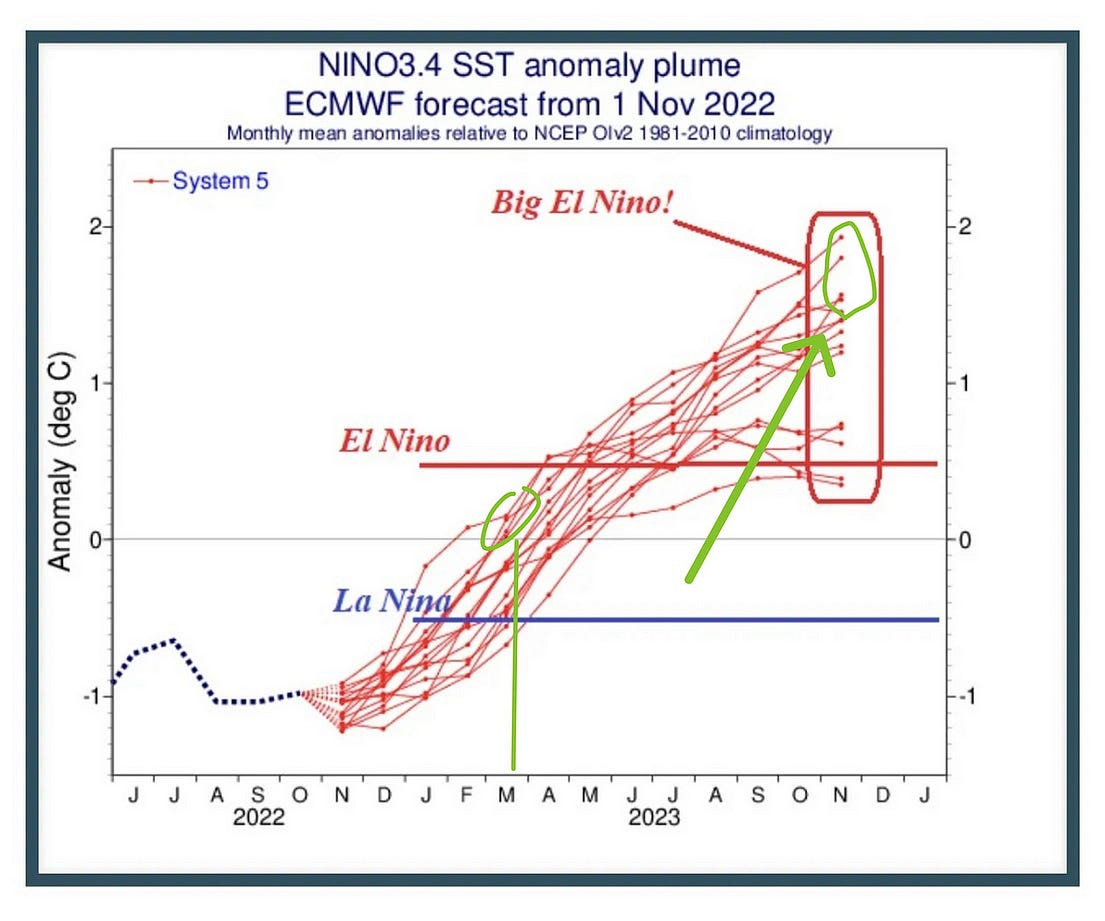
This is my analysis.
This is what I see.
This is my “Crisis Report”.
-rc 03262023




